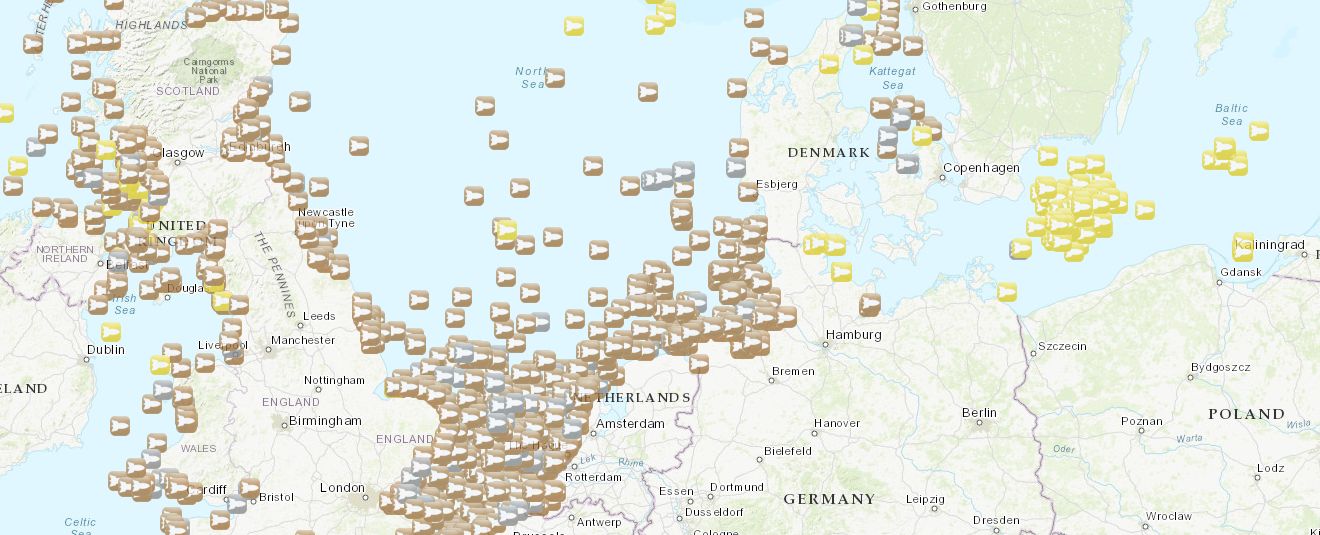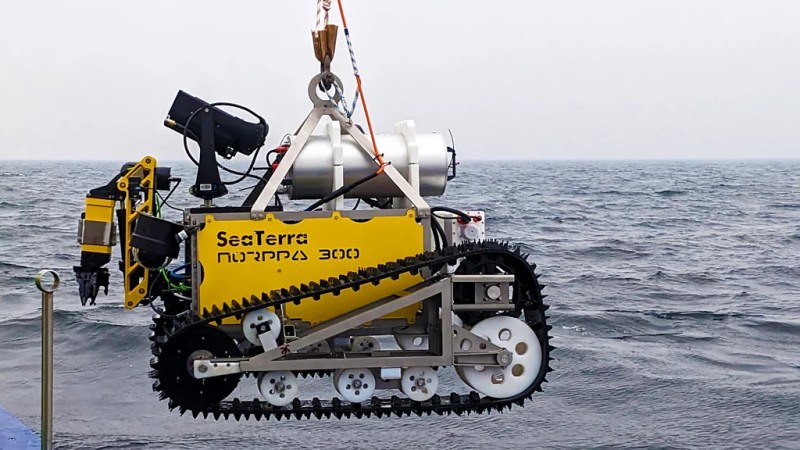Until the 1970s, a very common method to dispose of unneeded munitions was to simply tip them off the side of a ship. This means that everything from grenades to chemical weapons have been languishing in large quantities around Europe’s shorelines, right alongside other types of unexploded ordnance (UXO).
Although clearing and mapping such dump sites are a standard part of e.g. marine infrastructure such as undersea cabling and off-shore wind turbines, no large-scale effort has so far been undertaken to remove them, even as they continue to pose an increasing hazard to people and the environment. Most recently, efforts are underway to truly begin clearing these UXO, as the BBC reports.

Considering the hazards of these UXO, most interactions are performed by swimming and crawling robots, to find the UXO and grip it so that they can be gathered, classified and sorted with like types, for later disposal. Rather than explosively dispose of the UXO, they will instead be disassembled and the elements separately disposed of, including thermal decomposition of the explosive material by GEKA, a company which specializes in such disposal.
For the pilot project being undertaken in the Baltic Sea by SeaTerra and other companies, the goal for the first phase is to collect 50 tons of UXO. This of course is but the merest fraction of the estimated 1.6 million tons of explosives and weapons, and the chemical weapons would have to be treated with even more care in future operations.
For now the goal is to streamline and automate the UXO recovery and disposal process, so that the European seafloor and those around the world may one day be less riddled with UXO and other symptoms of humankind’s follies.















Study the effect seawater has on munitions.
Good until the munitions are deep enough the water contains no oxygen.
Then much slower, but also deep.
IIRC the large munitions on the ship in the Thames estuary are still dangerous.
The small ones have rusted through.
I’m honestly surprised some 14 year old English kid hasn’t been able to drop a firecracker on that wreck with a drone. Just for the luls.
And the effect of explosives and propelants to the environement. Lots of mercury in the primers.
So, maybe Nordstream pipeline blown up by a UXO that drifted because of under sea currents!
J/k
That’s better than thinking about the proximity to the Danish Naval Special Operations Center close by…
I think it might have been Put In there …
History has shown, if you want to get the Germans to change their political policy, it tends to involve blowing stuff up.
Along the northern sections of the New Jersey shore it is an annual task to replenish the beach sand by pumping or dredging sand from the ocean floor. Some of the places from which sand is obtained were also used to dump unwanted munitions at the end of the First World War. It is part of the task to have the explosive ordinance disposal folks go over the newly placed sand to find any such munitions.
So throwing bullets overboard will stop an offshore wind turbine farm? Hell yeah!
Nope.
So… you want to (albeit slightly) poison the ocean, a detriment to the livelihood of any of your neighbors who depend on it, just in the vague hope that you can stop anyone from doing something largely beneficial that you don’t like to look at?
Every technology that has been invented for the apparent good of man kind and then later discovered (ahem) as being terrible had the exact same type of people saying “why are you against this wonderful thing” which is somewhat later followed by said same types going “this was so obviously bad, why didn’t anyone speak up”
Go on, have a guess why.
So… what I’m hearing is that you’d rather store acidic drinks like wine in an old leaded container of some kind versus a modern bottle that’s coated in food-grade silicone on the inside? We’ve a long recorded history about the harmful effects of the lead, while silicone is unrelated to the families of plastics that contain BPA and seems pretty safe. Choose the better of your options instead of the worse one, that’s all I’m saying. And don’t deliberately poison people, which should be obvious but apparently not.
Yep, sometimes we get it wrong. But we also get it right! See the recent Hackaday article on pasteurization. Or look around at all the people who AREN’T dying or being maimed by smallpox. We know that smoking is bad, and we’re doing a lot less than we did in our parents’ generation. For every thalidomide there is a penicillin or an aspirin.
not only second world war, but also the first. huge piles were dumped after the armistice.
So a very expensive task has been sold to taxpayers for what benefit? How many UXOs lying on the sea floor explode each year? What are the consequences? I’m sure the number of fish killed is a vanishingly small fraction of those killed during the war.
Seems to me more like graft. Certainly water depths less than 50-100 ft should be cleared, but in deeper water what are the potential consequences?
It’s not just explosives, but also shells with chemical warfare agents. Some of them decompose upon contact with water, while others lead to additional introduction of arsenic compounds into the aquatic ecosystem.
(https://www.umweltbundesamt.de/trends-zur-verbreitung-von-munitionsresten-in-der).
Beyond that, it’s not easy to locate explosive object. But if you had the equipment, you could relocate large specimens to attack critical subsea infrastructure with reasonable deniability.
Our understanding of different future threats is evolving, so I personally welcome the effort to take it more seriously than in previous decades as long as the expenses are adequate for a lower-prioity mission.
Optical festoons, power cables, and oil and gas drilling and exploration equipment all have big money attached, so there is potentially value in making new viable seafloor real estate. UXO is often cited as a reason for not building a bridge across the Irish Sea, for example (though there are several other good reasons).
Also, much of the North Sea is quite shallow, and I wouldn’t bet against this old ordnance causing problems, especially if there’s stuff like lewisite that can get into the food chain.
I don’t know if anyone’s seriously proposing to clean up the whole ocean, but there are probably good reasons for the industry to exist, and it might need public funding to kickstart it.
> UXO is often cited as a reason for not building a bridge across the Irish Sea
I was going to say, when Boris Johnson was UK Prime Minister he shouted “build a bridge between Northern Ireland and Scotland!” to try to convince people he cared about regional development, and a bunch of people pointed out that this would mosty likely have to cross Beaufort’s Dyke, which is A) deeper than usuall for bridge building, and B) contains something like a million tons of UXO, a bunch of chemical weapons, and some radioactive waste. I’d be impressed if the outfit in the article ever scaled up as far as you’d need to deal with all of that.
Yeah. It’s always a great idea to let problems sit around and fester until they reach a point that people start dying and it costs 100x the time and effort to fix them.
Since we are in a watery mood, this works great for bridges and dams too!
Why do maintenance on bridges or dams every year? It’s cheaper to just use them until they collapse, and then rebuild them.
Obvious sarcasm…
Hey, how about this.
Your governments made this problem to begin with.
You already took the goods, which in this case was spending the disposal money on other things.
You are on the hook for the clean up money, because it’s a past due bill.
It’s not a new expenditure.
It’s a debt you have been ignoring.
I can’t remember who coined the law that when someone describes themselves as a taxpayer they’re about to say something stupid, but I feel like it just got another data point in its favour.
See “under paris” for the consequences of leaving them in the water…
(What do you mean it’s not a documentary?)
How about we drop them somewhere near you! It may cure your TDS!
Nuf said….
An explosive charge that was placed in Liberty Bell 7 is still out there—the SOFAR bomb:
https://en.m.wikipedia.org/wiki/Mercury-Redstone_4
https://evergreenexhibitions.com/exhibits/the-lost-spacecraft/
They could pick it up again looking for the door
According to your wiki link, you’re wrong about the bomb still being out there: “…experts removed and disposed of an explosive device (SOFAR bomb) that was supposed to detonate in the event of the spacecraft’s sinking, but which failed to explode.”
WALL-E!